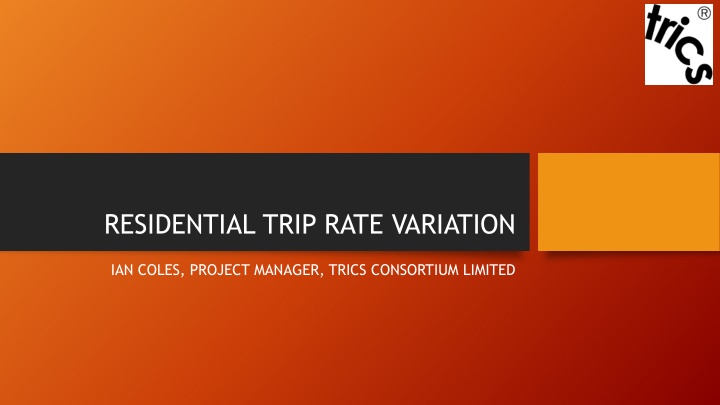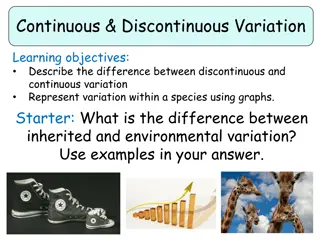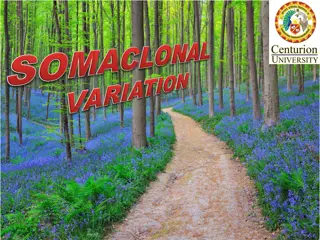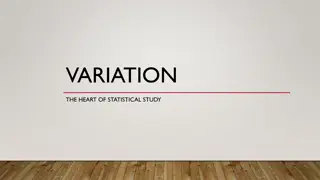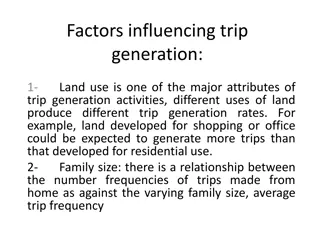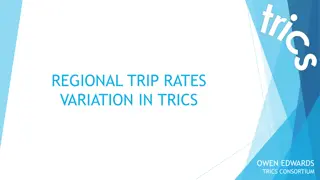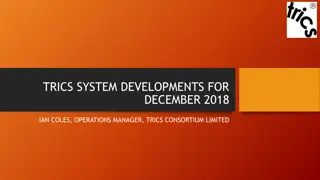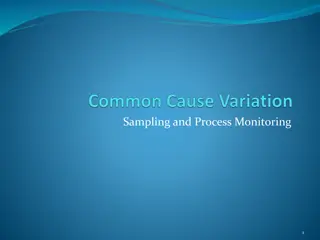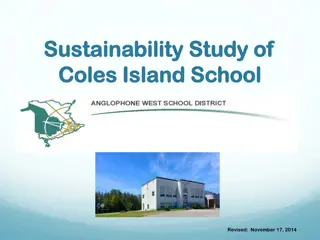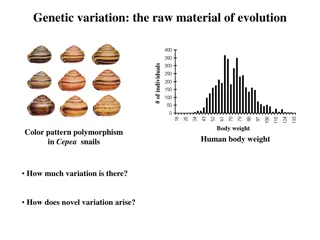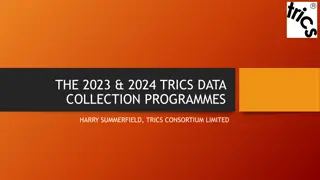Residential Trip Rate Variation Analysis by Ian Coles, Project Manager at TRICS Consortium Limited
Residential TRICS analyzes trip rate variation within different sub-categories based on ownership and housing types. The analysis includes sub-categories like Houses Privately Owned, Flats for Rent, Mixed Private Housing, and more. The study focuses on surveys conducted between 2000 and 2021, categorizing survey samples by location types. Calculations are done per dwelling for Total Vehicles and Total People, with trip rates displayed for specific time periods.
Download Presentation

Please find below an Image/Link to download the presentation.
The content on the website is provided AS IS for your information and personal use only. It may not be sold, licensed, or shared on other websites without obtaining consent from the author.If you encounter any issues during the download, it is possible that the publisher has removed the file from their server.
You are allowed to download the files provided on this website for personal or commercial use, subject to the condition that they are used lawfully. All files are the property of their respective owners.
The content on the website is provided AS IS for your information and personal use only. It may not be sold, licensed, or shared on other websites without obtaining consent from the author.
E N D
Presentation Transcript
RESIDENTIAL TRIP RATE VARIATION IAN COLES, PROJECT MANAGER, TRICS CONSORTIUM LIMITED
RESIDENTIAL TRIP RATE VARIATION Residential TRICS land uses have the highest number of annual trip rate calculations undertaken. Each sub-category is based on thresholds of flats to houses and privately owned to non-privately owned dwellings. This technical analysis looks at trip rate variation between Residential sub-categories.
RESIDENTIAL DEFINITIONS: OWNERSHIP Residential TRICS sites allocated to sub-categories based on 75% thresholds. 75% privately owned dwellings puts sites into a Privately Owned sub-category. TRICS defines a privately owned dwelling as one where a resident has any degree of equity (including shared ownership), or where a dwelling is owned and privately rented at market rates. Non-private dwellings are Housing Association rented or social (local authority) rented.
RESIDENTIAL DEFINITIONS: HOUSING TYPES Residential TRICS sites allocated to sub-categories based on 75% thresholds. 75% dwellings being houses puts sites into a Houses sub-category. For this threshold houses will include bungalows and flats will include houses split between two or more floors.
SUB-CATEGORIES INCLUDED IN THIS ANALYSIS 03/A (Houses Privately Owned) 03/B (Houses for Rent) 03/C (Flats Privately Owned) 03/D (Flats for Rent) 03/K (Mixed Private Housing) 03/L (Mixed Affordable Housing) 03/M (Mixed Private/Affordable Housing)
METHOD OF ANALYSIS: SELECTION CRITERIA All included surveys undertaken no later than 01/01/2000. Analyses split between surveys during 2000-2010 and 2011-2021. All surveys to be Monday-Friday. Separate analyses for Total Vehicles & Total People. Grouping of Suburban Area, Edge of Town & Neighbourhood Centre (excluding villages) TRICS Main Location types.
METHOD OF ANALYSIS: CALCULATIONS Calculations undertaking per 1 Dwelling. First calculation for Total Vehicles. Second calculation for Total People. Inbound and outbound trip rates to be displayed separately for 0700-1000, 1600-1900 and 0700-1900 periods. Trip rates also to be displayed for peak (two-way) hour for each calculation undertaken.
OBSERVATIONS: TRIP GENERATION COMPARISONS (VEHICLES) TRICS cannot provide any explanations, suggestions or reasoning behind the results, just some technical observations. Highest overall Total Vehicles trip rates were for 03/A (Houses Privately Owned), with 5.312 trips per dwelling for 2000-2010 and 4.642 trips for 2011-2021. Lowest was 03/C (Flats Privately Owned) and 03/D (Affordable/Local Authority Flats), with 2.022 & 1.895 trips (2000-2010), and 1.775 & 1.690 (2011-2021).
OBSERVATIONS: TRIP GENERATION COMPARISONS (VEHICLES) All but one of the categories show a noticeable decrease in Total Vehicles trip rates over time (average decrease of 5.4% from 2000-2010 to 2011-2021). In the 2000-2010 grouping the overall (in + out) peak hour was 1700-1800 for 4 of the 7 sub-categories (0.391 trips average). In the 2011-2021 grouping the peak hour was 0800-0900 for 5 of the 7 sub-categories (0.370 trips average decrease of 5.4%).
EXAMPLE OF TOTAL VEHICLES CALCULATION: 03/A (HOUSES PRIVATELY OWNED)
OBSERVATIONS: TRIP GENERATION COMPARISONS (PEOPLE) Highest overall Total People trip rates (0700-1900 period) were for 03/A (Houses Privately Owned), with 9.023 trips per dwelling for 2000-2010 and 7.955 trips for 2011-2021. Lowest was 03/C (Flats Privately Owned) and 03/D (Affordable/Local Authority Flats), with 4.445 & 5.071 trips (2000-2010), and 4.615 & 6.792 (2011-2021).
OBSERVATIONS: TRIP GENERATION COMPARISONS (PEOPLE) Unlike the Total Vehicles comparison, the Total People comparison did not show a consistent decrease over time for 0700-1900 across the sub-categories. However, on average the decrease was 5.9%. In the 2000-2010 grouping the overall (in + out) peak hour was 0800-0900 for 3 of the 5 sub-categories (0.847 trips average). Note two sub-categories had insufficient multi- modal surveys for this part of the analysis. In the 2011-2021 grouping the peak hour was 0800-0900 for all 5 sub-categories (0.822 trips average decrease of 3.0%).
EXAMPLE OF TOTAL PEOPLE CALCULATION: 03/A (HOUSES PRIVATELY OWNED)
OBSERVATIONS: MODE SPLIT COMPARISONS Highest Vehicle Occupants mode split (0700-1900 in + out) was 03/A (Houses Privately Owned), with 79.5% during 2000-2010 and 81.9% during 2011-2021. Highest Pedestrians mode split (0700-1900 in + out) was 03/D (Affordable/Local Authority Flats), with 46.6% during 2000-2010 and 36.4% during 2011-2021 (much higher than any of the other Residential sub-categories).
OBSERVATIONS: MODE SPLIT COMPARISONS Highest Cyclist mode split (0700-1900 in + out) was 03/M (Mixed Private/Affordable Housing), with 4.0% during 2000-2010 and 2.0% during 2011-2021. The highest sub- category for the 2011-2021 period was 03/C (Flats Privately Owned), although across the overall 2000-2021 period the 03/M sub-category had the highest Cyclist percentage.
OBSERVATIONS: MODE SPLIT COMPARISONS Highest Public Transport Users mode split (0700-1900 in + out) was 03/C (Flats Privately Owned), with 21.8% during 2000-2010 and 23.1% during 2011-2021. Mode shifts from 2000-2010 to 2011-2021 did not provide adequate consistency to highlight any specific observations, with figures fluctuating greatly (possibly due to low survey samples for some sub-categories). Pointing out any features from this may be misleading.
EXAMPLE OF MODE SPLITS: 03/A (HOUSES PRIVATELY OWNED)
